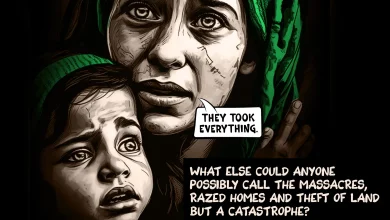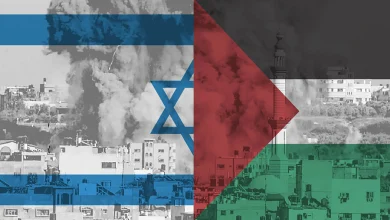The history of the Palestinian-Israeli conflict is intricate and multifaceted, marked by key events that have left a lasting impact on the region. This essay delves into a crucial period post-1948, exploring the settlement policies undertaken by the Israeli government and the Jewish Agency through the lens of declassified Israeli documents. As we dissect this historical chapter, it’s essential to navigate the complexities and emotions associated with the Palestinian-Israeli conflict.
Settlement Plans and Abandoned Villages: In the latter half of 1948, the settlement department of the Jewish Agency formulated plans to repopulate abandoned Arab villages, laying the foundation for a new era. These plans involved demolishing some villages for new settlements, a contentious move criticised by some Cabinet ministers. The debate highlights the tensions within the Israeli leadership regarding the destruction of villages, revealing the complexities of post-war decision-making.
Leadership Dynamics and Security Concerns: Prime Minister Ben-Gurion’s role and influence become apparent in decisions related to the destruction and repopulation of villages. Security concerns, as articulated by the commander of the central front, Tsvi Ayalon, led to the partial demolition of 14 Arab villages, showcasing the delicate balance between security imperatives and political considerations.
Jewish National Fund and Land Redemption: Yosef Weitz, a key figure in the Jewish National Fund, played a pivotal role in the settlement efforts. The essay explores Weitz’s perspective on land redemption, emphasising the acquisition of land from Arab owners. The tension between Weitz’s approach and Ben-Gurion’s preference for expropriation rather than purchase sheds light on divergent strategies within the Zionist movement.
Case Study: Deir Yassin and Symbolic Concerns: The resettlement of Deir Yassin, a village infamous for a massacre during the 1948 war, becomes a focal point of discussion. Noted scholars, including Martin Buber, express symbolic concerns about settling the village too soon, urging caution and emphasising the need for time to heal wounds. This case study provides insights into the intersection of historical trauma and settlement policies.
Knesset Debates and Controversial References: A Knesset debate on the return of Arab refugees reveals contrasting views among members. References to Deir Yassin spark controversy, with some members associating it with a positive outcome in the war, while others caution against boasting about it. This section explores the political discourse surrounding historical events and their impact on contemporary debates.
Global Precedents and Absentees’ Properties Law: Finance Minister Kaplan’s presentation of the Absentees’ Properties Law in the Knesset draws parallels with global precedents, attempting to contextualize Israeli actions. The essay examines these global comparisons and the potential influence on international perceptions of Israel’s policies.
Zerah Warhaftig’s Speech and Connection to the Land: Dr. Zerah Warhaftig’s poignant speech in the Knesset underscores the historical connection of the Jewish people to the land. By exploring Warhaftig’s words, we gain insights into the narrative of a people without land for generations, now asserting their identity through statehood and ownership.
Media Portrayal and Immigrant Absorption Concerns: The essay investigates how the media portrayed the resettlement of abandoned villages and the broader narrative of immigrant absorption. Haaretz’s concern about a potential crisis in immigrant absorption sheds light on the challenges faced by the newly established state and its commitment to housing a burgeoning population.
As we unravel the intricacies of post-1948 settlements through declassified Israeli documents, a profound understanding emerges of the intricate decision-making processes, political intricacies, and symbolic considerations that have sculpted the landscape of Israel. This essay stands as a comprehensive journey through a pivotal historical epoch, compelling readers to grapple with the nuanced layers of the Palestinian-Israeli conflict and its lasting repercussions.
In the context of modern Israel, where citizens may not be fully acquainted with the depths of their own history, it becomes imperative to reflect not only on the past but also on the path forward. The Zionist movement, while pivotal in the establishment of the state, is not without its complexities and challenges. This history serves as a testament to the importance of fostering peace and dialogue rather than perpetuating a protracted civil dispute.
As citizens of a democratic state, it is incumbent upon us to recognise the need for constructive engagement and coexistence. The past has shown us the consequences of division, and the path forward lies in acknowledging the diverse perspectives within our society. Anti-Zionism, like any ideology, warrants scrutiny, but our focus should transcend discord and aim towards a shared vision for a prosperous future.
Crucially, the call for peace is not a dismissal of historical grievances or a compromise of principles. Rather, it is an invitation to transcend the boundaries of longstanding disputes and seek common ground. The Israeli government, as a representative of its citizens, must prioritize the welfare and aspirations of its people. A shift towards a more inclusive governance model, where civilians are active participants in shaping policies, is not just a desirable objective but a necessity for sustainable coexistence.
Moreover, the vision for a greater, better future extends beyond national borders. Recognising the rights of the Palestinian people to self-determination and equal democratic representation is not just a moral imperative but a pragmatic approach to fostering enduring stability in the region. A democratic state, founded on principles of equality and justice, necessitates the inclusion of all voices, irrespective of their historical affiliations.
In conclusion, the exploration of post-1948 settlements serves as a critical juncture for introspection and growth. It beckons us to transcend the constraints of history and envision a future where Israelis and Palestinians coexist in a democratic framework that upholds the values of justice, equality, and shared prosperity. The call for peace is not merely an aspiration; it is a pragmatic path towards securing a legacy of unity, understanding, and collaborative nation-building.



